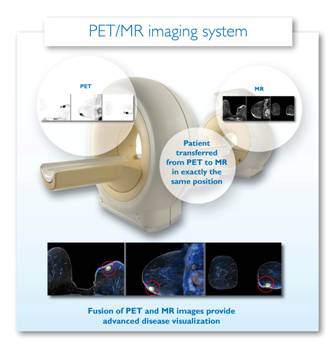Philips receives CE mark for PET/MRI system — first new modality in 10 years
24 Jan 2011
Royal Philips Electronics has been awarded the CE mark for its whole-body PET/MR imaging system, the Ingenuity TF PET/MR system.
This new combined imaging system, the industry’s first commercially available, is also Philips first new modality in ten years. It integrates the molecular imaging capabilities of PET (positron emission tomography) with the superior soft tissue contrast of MR (magnetic resonance) to image disease cells as they proliferate in soft tissue.
The system is not yet available commercially in the US, which tends to take longer to approve new technology.

Since the Ingenuity TF PET and MR scanners are placed only three meters apart and the patient table rotates to allow the patient to be scanned by each modality, the system can also acquire separate PET and MR images.
The combined PET/MRI scanner was developed in just over a year by Philips with the Translational and Molecular Imaging Institute, Department of Radiology, Mount Sinai School of Medicine, New York. MTB Europe reported on the inauguration of the second, and Europe's first, scanner at the University Hospitals of Geneva in May 2010 (PET-MRI scanner opens new frontier in medical imaging). The Institute of Radiopharmacy, Helmholtz-Zentrum Dresden-Rossendorf (HZDR), Dresden, Germany has also installed one and more are expected this year.
Philips has also developed a novel delivery system — the complete scanner suite can be delivered ready-to-use in a 48 tonne container, needing only a suitable foundation and connection to utilities.
Clinicians anticipate using the Ingenuity TF PET/MR to screen patients at high-risk for heart disease to ultimately treat diseased cells prior to the formation of dangerous coronary plaques. The system may also be used to scan patients to detect tumour formation/recurrence.
Since the Ingenuity TF PET/MR provides the best of Astonish TF PET and 3T MR, it is also possible to track whether a drug is reaching a tumour or plaque and monitor efficacy on a potential cellular level. In addition to greater visualization of disease process, the system can also produce up to 70% less ionizing radiation than PET/CT.
The future of personalized medicine
The combination of advances in high resolution MR and the ability to combine MR and PET into one whole body system has lead healthcare professionals to believe that the Ingenuity TF PET/MR will help identify disease sooner and make personalized medicine a reality.
“It’s rare to develop a modality that completely revolutionizes imaging; usually, companies can only strive for clearer images at a lower dose. With the Ingenuity TF PET/MR, researchers are experiencing breakthroughs on multiple fronts.
"They are able to effectively image the prostate for the first time and detect deadly cancers in organs such as the pancreas at a significantly earlier stage,” said Dominic Smith, vice president of marketing, Computed Tomography and Nuclear Medicine for Philips Healthcare.
“The Ingenuity TF PET/MR provides researchers and clinicians an unprecedented opportunity to make earlier diagnoses and personalize treatments for oncology and cardiology.”
Video
Prof. Osman Ratib talks about the
PET/MR scanner